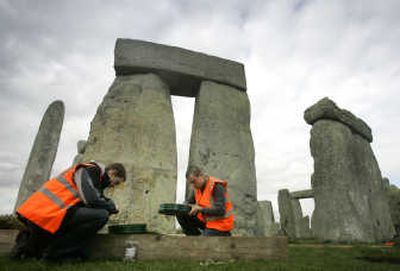Stonehenge burial site for centuries, experts say

WASHINGTON – The secret of Stonehenge has apparently been solved: The mysterious circle of large stones in southern England was primarily a burial ground for almost five centuries, and the site probably holds the remains of a family that long ruled the area, new research concludes.
Based on radiocarbon dating of cremated bones up to 5,000 years old, researchers with the Stonehenge Riverside Project said they are convinced the area was built and then grew as a “domain of the ancestors.”
“It’s now clear that burials were a major component of Stonehenge in all its main stages,” said Mike Parker Pearson, an archaeology professor at the University of Sheffield in England and head of the project. “Stonehenge was a place of burial from its beginning to its zenith in the mid-third millennium B.C.”
The finding marks a significant rethinking of Stonehenge. In the past it was believed that some burials took place there for a century but that the site’s significance lay in its ceremonial and religious functions, including serving as a center for healing.
A combination of the radiocarbon dating, excavations nearby that have revealed a once-thriving village and the fact that the number of cremated remains appeared to grow over a 500-year period convinced researchers that the site was used for a long time and most likely was a burial ground for one ruling family.
Parker Pearson said the discovery of a mace head – the enlarged end of a clubbing weapon – supports the theory that it was the province of a ruling family because it was long a symbol of authority in England and still serves that function in the House of Commons.
He said family members for as many as 30 to 40 generations were buried there, with the number of individuals increasing with each generation.
The team also excavated homes nearby at Durrington Walls, which they said were especially well preserved and appeared to be seasonal dwellings related to Stonehenge.
“It’s a quite extraordinary settlement. We’ve never seen anything like it before,” Parker Pearson said. The village had at least 300 and as many as 1,000 homes, which apparently were occupied in the midwinter and midsummer. Broad avenues leading from Stonehenge to the River Avon, as well as another leading to the river from a circle of wooden pillars close to the village, were oriented to the winter and summer solstices.
“All in all, we’re finding that Stonehenge was a sophisticated society with great achievements,” he said. The site fell into disuse around 1500 B.C., and over the centuries some of its stones were hauled off and broken.
The research was supported by the National Geographic Society, which features Stonehenge in the June edition of its magazine and will air a television special called “Stonehenge Decoded” on Sunday.